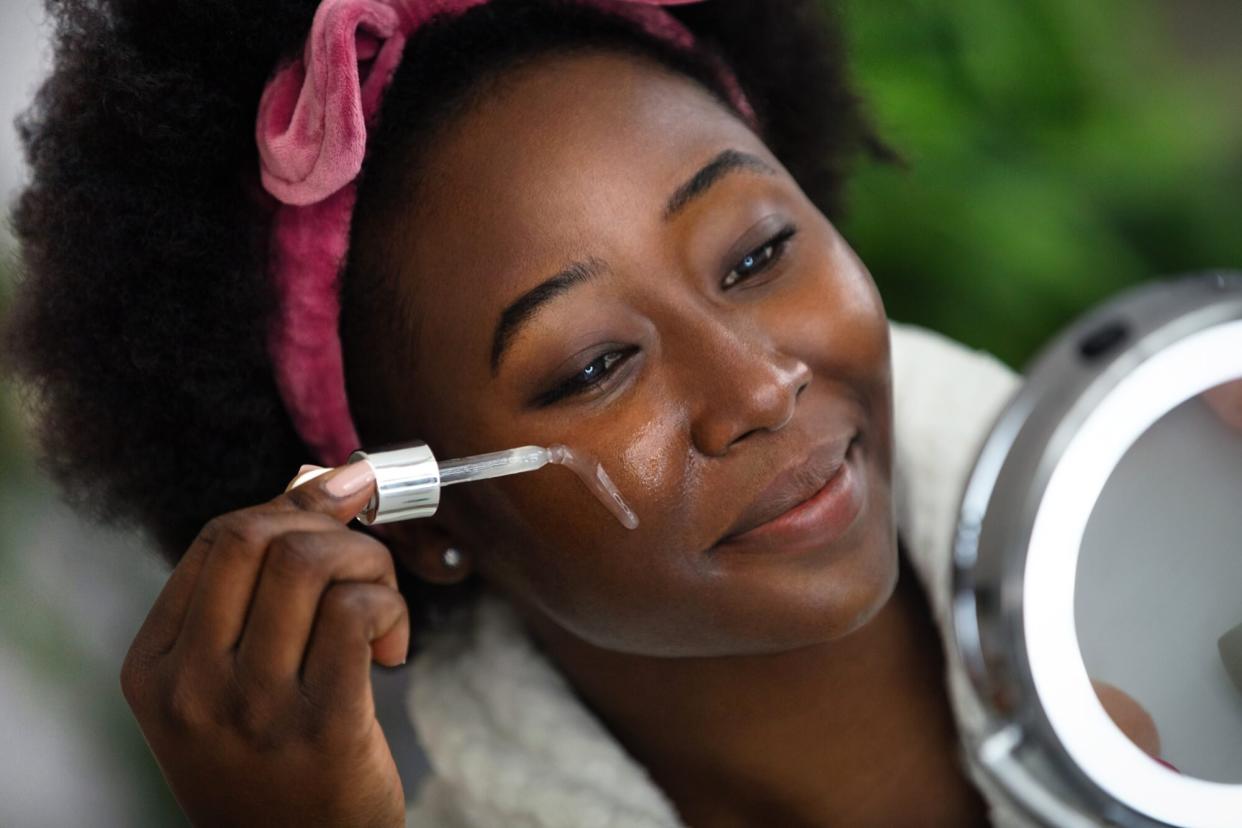AHAs vs. BHAs: Which Chemical Exfoliant Should You Use?

Getty Images
If your skincare goals consist of a clear, glowing, and smooth complexion, exfoliation will help you reach the finish line.
Exfoliation doesn't just refer to gritty formulas that physically remove dead skin cells from your face. Certain skincare acids chemically dissolve the buildup — no scrubbing required. There are a handful of chemical exfoliants used in skincare, with AHAs and BHAs being the most popular.
One isn't better than the other, but AHAs and BHAs do treat different skin issues. It's also common to see both types of acids together in skincare formulas for maximum results for certain skin issues, such as acne.
Ahead, we tapped two top dermatologists to help us understand how the two chemical exfoliants work, what makes them different, and how to use them in your skincare routine.
RELATED: The Best Exfoliants to Use in Your Skincare Routine
What Are AHAs?
AHAs are short for alpha-hydroxy acids. These natural plant- and animal-derived acids are commonly used to treat dry skin, aging skin, a d acne. "Commonly used AHAs in skincare are lactic and glycolic acids," explains Dr. Melanie Palm, a California-based board-certified dermatologist at Art of Skin MD.
With age, our skin tends to accumulate more dead skin cells as our natural skin cell cycle slows down. Unfortunately, this can make your skin look dull. "AHAs are primarily used to help exfoliate, which works by removing the top layers of dead skin cells to make way for new skin cell generation," Dr. Palm explains.
AHAs can be found in many types of skincare products, including serums, toners, masks, and moisturizers. "AHAs have gained popularity in skincare due to their ability to target the superficial layer of skin, therefore helping with skin texture, tone, hyperpigmentation, acne, the appearance of fine lines, and more," Dr. Palm says.
What Are BHAs?
BHAs stand for beta-hydroxy acids. These chemical exfoliants break down oil and dead skin cells that clog pores. "The most common BHA is salicylic acid," shares Dr. Sheila Farhang, an Arizone-based board-certified dermatologist and founder of Avant Dermatology. "This ingredient is best used for oily and acne-prone skin." Willow bark extract is a natural ingredient that converts itself into salicylic acid and is commonly used in skincare formulas.
Salicylic acid is known to fight bacteria, which is why it's also used as a treatment for warts. (Dr. Farhang calls out Compound W).
As far as skincare products go, BHAs are commonly found in spot treatments, pimple patches, serums, toners, chemical peels, masks, and even some foundation formulas catered to oily and acne-prone skin.
RELATED: How to Get a Professional-Grade Medical Peel at Home
AHAs vs. BHAs: What's the Difference?
While AHAs and BHAs are both chemical exfoliants, they have different properties that produce different effects.
"One of the biggest distinctions between the two is AHAs clear the excess dead skin buildup and reduce the concentration of calcium ions in the skin, whereas BHAs have antibacterial and anti-inflammatory properties while cutting through the oil in the pores and cause less irritation," Dr. Palm explains.
In addition, BHAs are follicutropic, which means they better penetrate the pore down the hair follicle to where acne starts. This is why they're the preferred chemical exfoliant for breakouts.
However, because both AHAs and BHAs make the skin more susceptible to sun damage, so it's important to wear sunscreen with at least SPF 30 for adequate protection.
What Are the Side Effects of AHAs and BHAs?
As with many active ingredients in skincare, AHAs do have possible side effects. If you're new to using chemical exfoliants, Dr. Palm says you may experience mild itching or irritation as you get used to the product.
While many people fare well with AHAs, those with inflammatory skin conditions such as rosacea, eczema, or psoriasis may find the acids too irritating. If you experience any of these skin conditions, Dr. Palm recommends consulting a dermatologist and patch-testing a product before applying it to your face.
BHAs have the potential to be drying and irritating. Dr. Farhang says to avoid using them on open skin, active infection, or a known allergy.
VIDEO: The Best Skincare Routine for Acne, According to Dermatologists
Can You Combine AHAs and BHAs?
While AHAs are typically used to treat signs of aging and discoloration because they're more aggressive exfoliators and BHAs are popular for acne-prone skin because of their antibacterial and anti-inflammatory properties, they can be combined.
"A combination of the two could work in some cases, but it's important to not overdo it as this could lead to compromising your skin barrier, resulting in irritation, redness, and other complications," says Dr. Palm.
Dr. Farhang suggests exfoliating once and week. "Choosing between really comes down to your skin type, sensitivity, and skin goals," she confirms.
